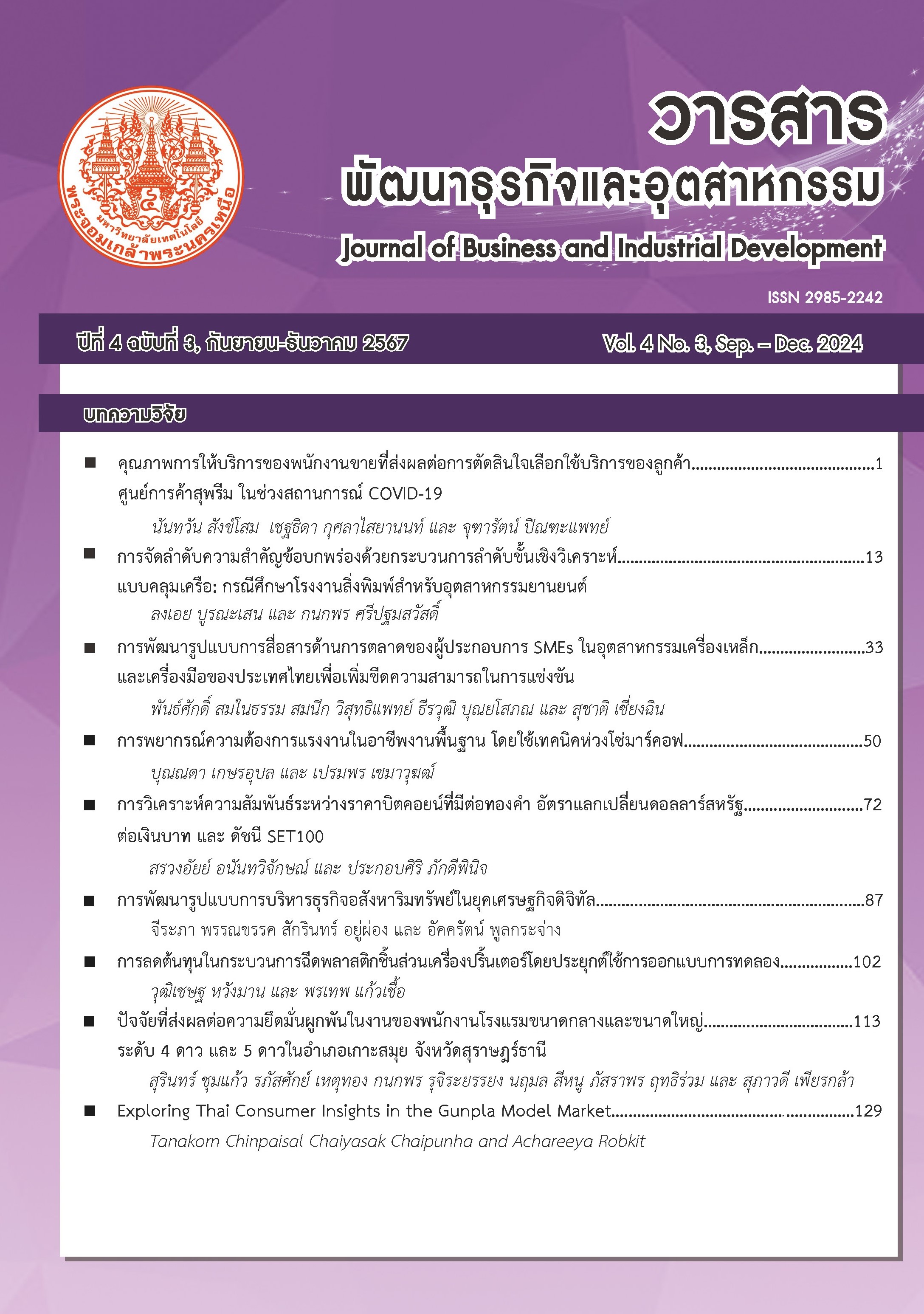การจัดลำดับความสำคัญข้อบกพร่องด้วยกระบวนการลำดับขั้นเชิงวิเคราะห์แบบคลุมเครือ: กรณีศึกษาโรงงานสิ่งพิมพ์สำหรับอุตสาหกรรมยานยนต์
คำสำคัญ:
การจัดลำดับความสำคัญ, การวิเคราะห์ลักษณะข้อบกพร่องและผลกระทบ, กระบวนการลำดับชั้นเชิงวิเคราะห์แบบคลุมเครือ, อุตสาหกรรมยานยนต์บทคัดย่อ
งานวิจัยนี้มีวัตถุประสงค์ในการเสนอแนวทางการจัดลำดับความสำคัญของข้อบกพร่องเพื่อนำไปสู่การแก้ไข ประยุกต์ใช้ในกรณีศึกษาบริษัทงานพิมพ์เพื่ออุตสาหกรรมชิ้นส่วนยานยนต์ โดยใช้กระบวนการลำดับขั้นเชิงวิเคราะห์แบบคลุมเครือ (Fuzzy Analytic Hierarchy Process :FAHP) ภายใต้แนวคิดการประเมินความเสี่ยง FMEA (Failure Mode and Effect Analysis :FMEA) ในข้อกำหนดของมาตรฐานของ IATF 16949 ซึ่งเป็นมาตรฐานการผลิตชิ้นส่วนยานยนต์ที่ได้รับการยอมรับทั่วโลก โดยใช้เกณฑ์จาก AIAG&VDA FMEA Handbook ได้แก่ความรุนแรง (Severity: S) โอกาสเกิดข้อบกพร่อง (Occurrence: O) และการตรวจจับข้อบกพร่อง (Detection: D) และ เกณฑ์ตัดสินใจรอง ได้แก่ สาเหตุการเกิดข้อบกพร่องจาก 4M (Man, Machine, Method, Material) และสาเหตุการเกิดข้อบกพร่องจาก 1E (Environment) เริ่มจากรวบรวมข้อมูลการเกิดของเสีย เลือกของเสียหรือข้อบกพร่องมาจัดลำดับโดยใช้เกณฑ์ S, O, D ด้วย FAHP ผู้ตัดสินใจเป็นผู้ร่วมประชุมที่เกี่ยวข้องกับผลิตภัณฑ์จำนวน 20 ท่าน จากหลากหลายหน่วยงาน นำผลลัพธ์ที่ได้เปรียบเทียบกับวิธีการเดิมของบริษัท ได้แก่วิธี Risk Priority Number (RPN) และวิธี Action Priority (AP) พบว่าผลลำดับความสำคัญของข้อบกพร่องแตกต่างกันเล็กน้อย โดยวิธี FAHP ให้ผลลัพธ์ที่ได้รับการยอมรับมากกว่าเมื่อเทียบกับวิธีเดิม จากการคำนึงถึงน้ำหนักของเกณฑ์ และความคลุมเครือในการตัดสินใจของทีมงาน งานวิจัยนี้เน้นการประยุกต์ใช้เครื่องมือช่วยตัดสินใจแบบกลุ่ม (Group Decision Making) มีหลายหน่วยงานทำงานร่วมกันเป็นทีมงานข้ามสายงานภายในองค์กร (Cross Functional Team) แต่ละหน่วยงานคิดเห็นแตกต่างกันแต่ต้องตัดสินใจในเรื่องเดียวกัน เมื่อนำ FAHP มาช่วยในการตัดสินใจ ส่งผลให้ข้อสรุปได้รับการยอมรับมากขึ้น ลดการตัดสินใจแบบมีอคติ ลดความขัดแย้งระหว่างหน่วยงาน ในงานวิจัยพัฒนา Excel template ขึ้น ช่วยลดเวลาคำนวณและประมวลผลขั้นตอนที่ซับซ้อน สามารถวิเคราะห์และสรุปผลได้อย่างแม่นยำ รวดเร็วขึ้น
เอกสารอ้างอิง
Ploypanichcharoen, K. (2008). Failure Mode and Effect Analysis (2nd ed.). Technology Promotion Association (Thai–Japan). (in Thai)
Automotive Industry Action Group (AIAG). (2011). Failure Mode and Effects Analysis (FMEA)(4th ed.). United States: AIAG.
Automotive Industry Action Group (AIAG) & Verband der Automobilindustrie (VDA). (2019). Failure Mode and Effects Analysis (FMEA) Handbook. United States: AIAG.
Emrouznejad, A., & Ho, W. (2018). FAHP Fuzzy Analytic Hierarchy Process (1st ed.). CRC Press Taylor & Francis Group.
Ivančić, V. (2014). Improving the Decision-Making Process Through the Pareto Principle Application. Ekonomska Misao i Praksa, (2), 633–656.
Opasanon, S. (2013). Multi Criteria Decision Making. Logistics and Supply Chain Management, 35(139), 1–4. (in Thai)
Khuanchai, I. (2015). Prioritization of Failure Modes by Using Fuzzy Analytic Hierarchy Process (FAHP): A Case Study of Electronics Part/Components Manufacturing Process [Master of Engineering]. Thammasat University. (in Thai)
Rangsikornphum, K. (2022). Decision Analysis for Engineering (1st ed.). Chulalongkorn University Press (CUPRINT). (in Thai)
Calabrese, A., Costa, R., Levialdi, N., & Menichini, T. (2016). A Fuzzy Analytic Hierarchy Process Method to Support Materiality Assessment in Sustainability Reporting. Journal of Cleaner Production, 121, 248–264. https://doi.org/10.1016/j.jclepro.2015.12.005
Zadeh, L. A. (1965). Fuzzy Sets. Information and Control, 8, 338–353. https://doi.org/10.1016/S0019-9958(65)90241-X
Van Laarhoven, P. J. M., & Pedrycz, W. (1983). A Fuzzy Extension of Saaty’s Priority Theory. Fuzzy Sets and Systems, 11(1–3), 229–241. https://doi.org/10.1016/S0165-0114(83)80082-7
Buckley, J. J. (1985). Fuzzy Hierarchical Analysis. Fuzzy Sets and Systems, 17(3), 233–247.
Onar, S. Ç., Büyüközkan, G., Öztayşi, B., & Kahraman, C. (2016). A New Hesitant Fuzzy QFD Approach: An Application to Computer Workstation Selection. Applied Soft Computing, 46, 1–16. https://doi.org/10.1016/j.asoc.2016.04.023
Saaty, T. L. (1994). How to Make a Decision: The Analytic Hierarchy Process. Interfaces, 24(6), 19–43.
Metinee, J. (2016). Green Supply Chain Management Triple Bottom Line and Organization Theory Prioritization with Fuzzy AHP Method [Master of Engineering]. Thammasat University. (in Thai)
Thanitchet, D. (2023). Model Development Using the Fuzzy AHP Technique for Construction Safety Assessment, Phuket. The 28th National Convention on Civil Engineering, 28, 1–9.
ดาวน์โหลด
เผยแพร่แล้ว
รูปแบบการอ้างอิง
ฉบับ
ประเภทบทความ
สัญญาอนุญาต
ลิขสิทธิ์ (c) 2024 วารสารพัฒนาธุรกิจและอุตสาหกรรม

อนุญาตภายใต้เงื่อนไข Creative Commons Attribution-NonCommercial-NoDerivatives 4.0 International License.





